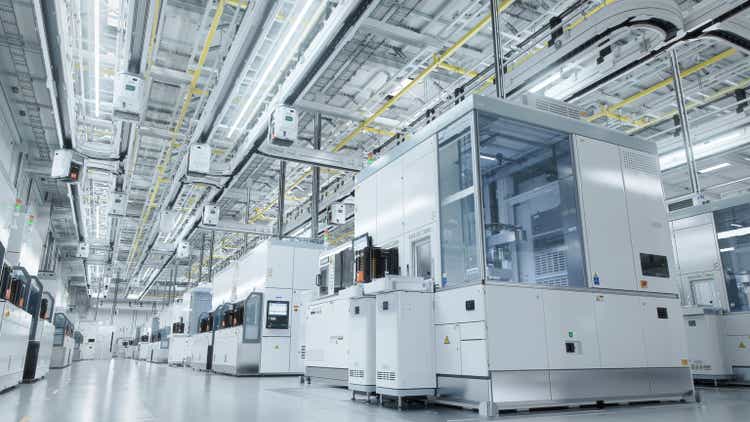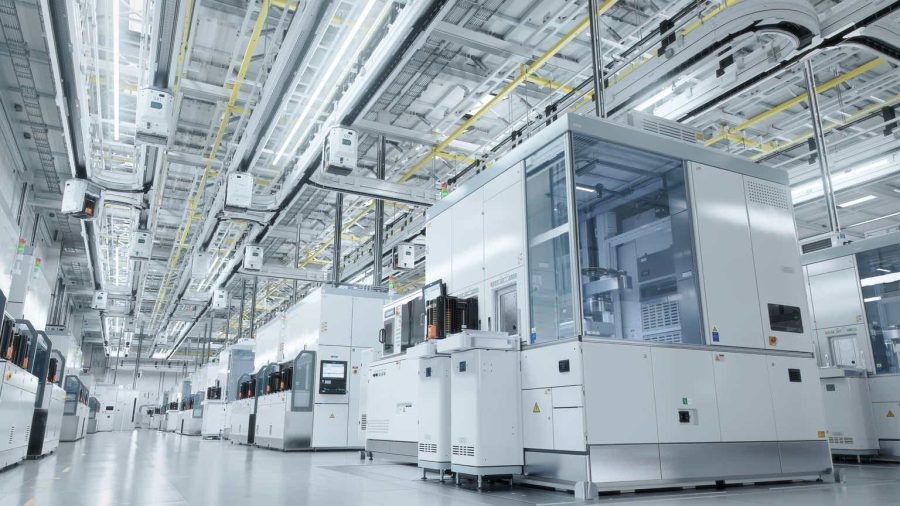Summary:
- There have been restrictions placed on US companies, which prevent them from selling their most up-to-date technology to China.
- These restrictions have backfired and negatively impacted US semiconductor companies.
- Naura Technology Group showing impressive financial growth compared to Applied Materials.
SweetBunFactory
Preamble
The second article I penned for Seeking Alpha covered a rather obscure German stock called Aixtron. Amongst other things, the company specialises in manufacturing equipment that utilises a unique deposition technology, critical for the production of sophisticated compound semiconductors.
At the time of publication in February 2019, the stock traded at $10.68 and reached a high of around $42.65 in December 2023. This represents a gain of approximately 300% for the period noted. For interest, the Compound Annual Growth Rate for this timeframe was approximately 33%, comfortably beating the market. However, since then, the stock has pulled back to $23.93, despite the boom in all things semiconductor. This drop is getting on for 50%, Phew!
One potential reason for the drop in the share price has been a problem with short-term supply and demand imbalances. In addition, there have been issues with export licenses, which led to missed targets. There was also a lowered guidance due to SiC (Silicon Carbide) market difficulties.
However, the last quarterly report was really encouraging for investors; revenues up 53%, net profit up 114%, large orders from China and so on.
If there was one fly in the ointment, so to speak, it was the emergence of a new Chinese competitor; AMEC (Shanghai listed – 688012). Established in 2004 by former Applied Materials employees, which was financed by, amongst others, Qualcomm and Samsung. Within three years, AMEC developed its own etching machine, which was used in TSMC’s 7 nm process to produce chips for iPhones.
Nowadays, “the company’s etch tools enable chipmakers to build devices for diverse applications at nodes as low as 5nm.” And reportedly competes head on with Aixtron for MOCVD (Metal Organic Chemical Vapor Deposition) Systems.
The reason I mention Aixtron and their Chinese competitor is that Applied Materials, Inc. (NASDAQ:AMAT) also has a rising Chinese counterpart in the shape of Naura Technology Group (Shanghai listed – 002371), which constitutes the lion’s share of this article.
Also covered in this piece are the not-so-obvious catalysts that will drive the rise of Naura at the expense of Applied Materials.
Finally, may I advise readers that I am long the Shanghai listed companies AMEC and Naura Technologies Group.
Applied Materials
Applied Materials, founded in 1967, is a global leader in materials engineering solutions, specializing in equipment, services, and software for the semiconductor and display industries.
The company’s expertise in materials engineering drives innovative solutions that combine multiple processes and customized metrology to create faster, more efficient chips, meeting the increasing demand for high-performance semiconductors in areas such as artificial intelligence.
Headquartered in Santa Clara, California, Applied Materials’ global presence and commitment to innovation have positioned it as a key player in shaping the future of electronics.
Financials
Reviewing the most recent Form 10-Q, there were both positives and negatives in my view.
Positives
- Applied Materials has seen an uplift in revenue in the Applied Global Services segment due to higher demand for long-term service agreements and 200mm generation equipment.
- The Display and Adjacent Markets segment has also seen a gain in revenue due to increased investment in display manufacturing equipment for IT products.
- The company has a strong cash position with $10.5 billion in cash, cash equivalents, and investments.
- The company has been actively repurchasing shares, with $11.2 billion remaining available for future repurchases under the program. So, it is likely that Earnings Per Share (“EPS”) will continue higher, for a while at least.
I imagine most, if not all, investors would consider the increase in EPS to be very positive. However, the share repurchase program likely contributed to the rise in EPS given that the company repurchased shares throughout the six months ending on April 28, 2024. Of course, with a lower number of shares and a modest climb in net income, the earnings per share rose more than would be expected.
The report states that the company repurchased $1.5 billion worth of stock during the period. Given the significant amount of money involved in the buyback program, it is reasonable to infer that it had a material impact on the EPS, as the table below shows.
| Period | Net Income April 2023 (Millions) | Net Income April 2024 (Millions) | Diluted EPS April 2023 | Diluted EPS April 2024 | Percentage Change in Net Income | Percentage Change in Diluted EPS |
| 3 Months Ended April 28, 2024 | $1,575 | $1,722 | $1.87 | $2.06 | 9.30% | 10.16% |
| 6 Months Ended April 28, 2024 | $3,292 | $3,741 | $3.88 | $4.47 | 13.70% | 15.20% |
Another positive is that the company managed to increase sales in China by a whopping 101% (From $1,405 Million Q April 2023 to $2,831 Million Q April 2024), despite the various restrictions discussed below. From the 10-Q report, it can be seen that China now accounts for a hefty 43% of sales.
Negatives
- The Semiconductor Systems segment has seen a very low increase in revenue due to lower customer demand.
- The company is facing ongoing supply chain constraints and the risk of excess or obsolete inventory.
Since 2022
In October 2022, the United States implemented stringent export controls on advanced semiconductors manufacturing equipment to China, aiming to restrict China’s access to cutting-edge technology. However, recent data from the Federal Reserve Bank reveals that these controls have been counterproductive, causing significant harm to the U.S. semiconductor industry while inadvertently bolstering China’s.
According to the report, American companies have experienced substantial losses, with a $130 billion decrease in market capitalization, as they were forced to sever ties with both restricted and non-restricted Chinese companies due to the heightened risk environment. Efforts to find alternative markets outside of China have proven futile, as the Chinese market is simply too large to replace.
The losses of revenue resulting from export controls have significantly affected the U.S. semiconductor industry by undermining its economies of scale. Semiconductor manufacturing requires substantial upfront investments, as evidenced by the nearly $50 billion spent by U.S. firms in 2022.
To recover these costs and maintain competitive prices, companies must maximize sales. Higher production and sales volumes allow companies to distribute and absorb per-unit costs, enabling them to offer more competitive prices. Additionally, increased revenue provides more funds for further investment in capital and research and development.
Meanwhile, China has rapidly expanded its domestic semiconductor manufacturing capabilities, substituting American suppliers with local alternatives and accelerating the development of advanced chips.
The U.S. government’s attempts to persuade allies to adopt similar export restrictions have been met with resistance, as these countries recognize the potential damage to their own industries.
Ultimately, the export controls have backfired, creating a “death spiral” for the U.S. semiconductor sector, characterized by declining revenues, profits, and competitiveness, while China’s semiconductor industry flourishes.
Naura Technology Group
Applied Materials and Naura Technology Group are both major players in the semiconductor equipment industry. Both companies compete in a number of product areas within the China market, which include:
- Etching equipment: Both companies offer a wide range of etching equipment, used to remove material from the surface of wafers.
- Physical vapor deposition (PVD) equipment: PVD equipment is used to deposit thin films of material onto wafers.
- Chemical vapor deposition (CVD) equipment: CVD equipment is used to deposit thin films of material onto wafers using chemical reactions.
- Other equipment: Both companies also offer a variety of other equipment, such as wet processing equipment.
Naura’s Financials
The company’s financials make for interesting reading, given the report described above. Naura’s total revenue increased by an impressive 51.36% in the three months ended March 2024 compared to the same period in 2023. Whereas, Applied Materials’ total revenue increased by meagre 0.19% in the comparable three months ended April 2024 against the same period in 2023.
Naura’s net income increased by 80.74% in the three months ended March 2024 compared to the same period in 2023. Applied Materials’ net profit increased by 9.33% in the three months ended April 2024.
As noted, Applied Materials boosted EPS by means of buybacks, and despite this, Naura’s increase in EPS far exceeds that of Applied materials.
| NAURA Technology Group | Applied Materials | |||||
|
Mar ’23 |
Mar ’24 |
April ’23 | April ’24 | |||
|
Total Revenues |
$563.7 | $810.3 | $8,630 | $8,646 | ||
| Percentage Increase | 43.75% | 0.19% | ||||
| Net Income | $86.2 | $155.8 | $1,575 | $1,722 | ||
| Percentage Increase | 80.74% | 9.33% | ||||
| EPS | $0.2 | $0.3 | $1.87 | $2.06 | ||
| Percentage Increase | 50.00% | 10.16% | ||||
| Price To earnings | 41.68 | 29.36 | ||||
Summary
Applied Materials, has seen mixed financial results and continues to have a fairly rich valuation.
The U.S. government’s export controls on advanced semiconductor manufacturing equipment to China, intended to restrict China’s technological progress, have backfired. These controls have harmed American companies, by encouraging China to expand its domestic semiconductor manufacturing capabilities, substituting American suppliers with local alternatives.
Naura Technology Group, a Chinese competitor to Applied Materials, has seen significant growth, which contrasts with Applied Materials’ more modest rise.
Analyst’s Disclosure: I/we have no stock, option or similar derivative position in any of the companies mentioned, and no plans to initiate any such positions within the next 72 hours. I wrote this article myself, and it expresses my own opinions. I am not receiving compensation for it (other than from Seeking Alpha). I have no business relationship with any company whose stock is mentioned in this article.
I have a stock position in the Shanghai listed companies mentioned in the article
Seeking Alpha’s Disclosure: Past performance is no guarantee of future results. No recommendation or advice is being given as to whether any investment is suitable for a particular investor. Any views or opinions expressed above may not reflect those of Seeking Alpha as a whole. Seeking Alpha is not a licensed securities dealer, broker or US investment adviser or investment bank. Our analysts are third party authors that include both professional investors and individual investors who may not be licensed or certified by any institute or regulatory body.
